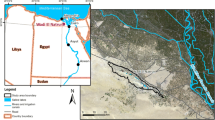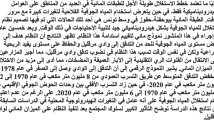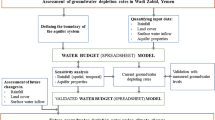Abstract
Due to large-scale agricultural irrigation and industrial production, groundwater had been excessively employed to benefit the economy development and life improvement in Chikugo-Saga plain since the middle of last century, which led to many environmental problems such as land subsidence, flooding inundation and water shortage. In order to mitigate the impact of environmental hazards, some water supply projects have been performed to substitute surface water for groundwater since 1970s. For the purpose of comprehending the influence of substitute water projects on groundwater withdrawals, a tempo-spatial groundwater withdrawals assessment model with the resolution of one month in time and one kilometer in space was initially established based on various data concerning meteorology, agriculture, land use, soils, surface water consumption and groundwater utilization by using GIS. According to the development of the substitute water projects, a 28-year study period 1979–2006 was then divided into four stages (i.e. 1979–1984, 1985–1995, 1996–2000 and 2001–2006) and the tempo-spatial distribution of groundwater withdrawals for each stage was represented by means of the proposed model. The tempo-spatial variation of groundwater withdrawals for various water use categories under the effect of substitute water projects was finally analyzed by comparing the distributions of groundwater withdrawals at different stages. The results show that with the advance of the substitute water projects studied, the groundwater pumpage for irrigation, industry or waterworks varies geographically and phasically in the plain. From the first stage to the last stage, there is a significant decrease by approximately 23 % in mean annual total groundwater withdrawals. During the study period, dramatic declines are found in agriculture-use groundwater pumpage in the downstream land of Chikugo river at the third stage, in industry-use pumpage in eastern Saga area at the second stage and found in waterworks-use pumpage in western Saga area at the last stage, while little change in agriculture-use pumpage in western Saga area and in industry-use pumpage in Chikugo area without the corresponding substitution projects. Moreover, it is indicated that the proposed assessment model of groundwater withdrawals is helpful to figure out the regional groundwater exploitation and its impact on the environment, particularly when there is the lack of groundwater pumpage data recorded. It is necessary to develop new substitute water supply plans to reduce the agriculture-use groundwater withdrawals in western Saga area and the industry-use withdrawals in Chikugo area, for more effective management of regional water resources in future.













Similar content being viewed by others
References
Abidin HZ, Gumilar I, Andreas H, Murdohardono D, Fukuda Y (2013) On causes and impacts of land subsidence in Bandung Basin, Indonesia. Environ Earth Sci 68(6):1545–1553. doi:10.1007/s12665-012-1848-z
Ahmad MD, Bastiaanssen GWM, Feddes RA (2005) A new technique to estimate net groundwater use across large irrigated areas by combining remote sensing and water balance approaches, Rechna Doab, Pakistan. Hydrogeol J 13:653–664. doi:10.1007/s10040-004-0394-5
Allen RG, Pereira LS, Raes D, Smith M (1998) Crop Evapotranspiration - Guidelines for Computing Crop Water Requirements. FAO Irrigation and Drainage Paper 56. Rome: Food and Agriculture Organization of the United Nations. http://www.fao.org/docrep/X0490E/x0490e00.htm
Bastiaanssen WGM, Molden D, Makin IW (2000) Remote sensing for irrigated agriculture: examples from research and possible applications. Agric Water Manag 46:137–155
Baumberger L, Hart V, Darkwah S (2007) Effect of GIS-based demand allocation on water distribution system modeling. Florida Water Resour J, 15–19
Cai Y, Mitani Y, Ikemi H, Liu SG (2012) Effect of precipitation timescale selection on tempo-spatial assessment of paddy water demand in Chikugo-Saga plain, Japan. Water Resour Manag 26:1731–1746. doi:10.1007/s11269-012-9984-5
Castaño S, Sanz D, Gómez-Alday JJ (2010) Methodology for quantifying groundwater abstractions for agriculture via remote sensing and GIS. Water Resour Manag 24(4):795–814. doi:10.1007/s11269-009-9473-7
Chowdary VM, Rao NH, Sarma PBS (2003) GIS-based decision support system for groundwater assessment in large irrigation projects areas. Agric Water Manag 62(3):229–252. doi:10.1016/S0378-3774(03)00144-6
D’haeze D, Raes D, Deckers J, Phong TA, Lou HV (2005) Groundwater extraction of Coffea canephora in Ea Tul watershed, Vietnam—a risk evaluation. Agric Water Manag 73:1–19. doi:10.1016/j.agwat.2004.10.003
Farg E, Arafat SM, Abd El-Wahed MS, EL-Gindy AM (2012) Estimation of evapotranspiration Etc and crop coefficient Kc of wheat, in South Nile delta of Egypt using integrated FAO-56 approach and remote sensing data. The Egyptian Journal of Remote Sensing and Space Sciences 15:83–89. doi:10.1016/j.ejrs.2012.02.001
Fiedler FR (2003) Simple, pratical method for determining station weights using Thiessen polygon and isohyetal maps. J Hydrol Eng 8(4):219–221. doi:10.1061/(ASCE)1084-0699(2003)8:4(219)
Fukuda T (2005) Actual water consumption and water management in paddy field –referring to the Thailand gravity irrigation district (2). J Fac Agric Kyushu Univ 50:883–888
Hachiya Y, Kitajima J, Jinno K (1996) Land subsidence in the saga plain due to water shortage in 1994. Journal of Groundwater Hydrology, Japanese Association of Groundwater Hydrology 38(3):181–191 (in Japanese)
Hachiya Y, Hino T, Shimoyama S, Miura N (2002) Mechanism of saltwater intrusion into groundwater in the Shiroishi plain. Journal of Environmental Systems and Engineering, Japanese Association of Groundwater Hydrology 706:51–59 (in Japanese)
Hosokawa T (1992) Study on numerical simulation and mechanism of seawater intrusion and effective extraction of groundwater. Kyushu University, Dissertation (in Japanese)
Jang MW, Choi JY, Lee JJ (2007) A spatial reasoning approach to estimating paddy rice water demand in Hwanghaenam-do, North Korea. Agric Water Manag 89:185–198. doi:10.1016/j.agwat.2007.01.009
Jha MK, Chowdhury A, Chowdary VM, Peiff S (2007) Groundwater management and development by integrated remote sensing and geographic information systems: prospects and constraints. Water Resour Manag 21:427–467. doi:10.1007/s11269-006-9024-4
Kawano H, Shiratani E, Kim NQ (1995) Estimation of upward moisture supply for the design of upland irrigation water requirement. Transactions of the Japanese Society of Irrigation, Drainage and Reclamation Engineering, No 175:9–15 (in Japanese)
Ko J, Piccinni G, Marek T, Howell T (2009) Determination of growth-stage-specific crop coefficients (Kc) of cotton and wheat. Agric Water Manag 96:1691–1697. doi:10.1016/j.agwat.2009.06.023
Kobayashi H (2005) Japanese water management systems from an economic perspective: the agricultural sector. Proceedings of Organization for Economic Co-operation and Development (OECD) workshop on agriculture and water: sustainability, markets and policies, 14–18 November, Adelaide, Australia
Kuroda M, Cho T (1988) Water management and operation of irrigation system in low lying paddy area with creek network. Irrigation Engineering and Rural Planning 13:36–46
Liu YJ, Luo Y (2010) Evaluation and improvement of the FAO-56 soil water stress coefficient approach using field experimental data. Resources science 32(10):1902–1909 (in Chinese)
Lynch SD, Schulze RE (1995) Techniques for estimating areal daily rainfall. 1995 ESRI International User Conference
Matsuda M (1980) Digital national land information. GeoJournal 4(4):313–318. doi:10.1007/BF00219578
Ministry of Agriculture, Forestry and Fisheries MAFF (1997) Design criterion for agricultural land improvement planning – agricultural irrigation for patch (technology), 175–213 (in Japanese)
Ministry of the Environment Government of Japan MOE (1995) Quality of the Environment in Japan 1995. http://www.env.go.jp/en/wpaper/1995/index.html
Mukherjee P, Singh CK, Mukherjee S (2012) Delineation of groundwater potential zones in arid region of India—a remote sensing and GIS approach. Water Resour Manag 26:2643–2672. doi:10.1007/s11269-012-0038-9
Portoghese I, Uricchio V, Vurro M (2005) A GIS tool for hydrogeological water balance evaluation on a regional scale in semi-arid environments. Comput Geosci 31:15–27. doi:10.1016/j.cageo.2004.09.001
River Association of Japan RAJ (1997) Japanese technical criterion for river erosion and torrent control and its commentary: planning conducted by ministry of land, infrastructure, transport and tourism of Japan. Sankaido, Tokyo (in Japanese)
Ruud N, Harter T, Naugle A (2004) Estimation of groundwater pumping as closure to the water balance of a semi-arid, irrigated agricultural basin. J Hydrol 297:51–73. doi:10.1016/j.jhydrol.2004.04.014
Saga prefectural government (1995) Records on drought events from 1994 to 1995. Saga prefectural government, Saga, pp 10–36 (in Japanese)
Saga prefectural government (2001) A survey on land subsidence in 2000. Saga prefectural government, Saga, pp 1–12 (in Japanese)
Sakamoto K, Yamashita S (1989) A study on the system of water-usage by drawing “Ao” (freshwater) as a source of irrigation in the Chikugo lower basin. Environmental System Research 17:113–117 (in Japanese)
Sun H, Grandstaff D, Shagam R (1999) Land subsidence due to groundwater withdrawal: potential damage of subsidence and sea level rise in southern New Jersey, USA. Environ Geol 37(4):290–296. doi:10.1007/s002540050386
Tilahun K, Merkel BJ (2009) Estimation of groundwater recharge using a GIS-based distributed water balance model in Dire Dawa, Ethiopia. Hydrogeol J 17:1443–1457. doi:10.1007/s10040-009-0455-x
Tsanis K, Apostolaki MG (2009) Estimating groundwater withdrawal in poorly gauged agricultural basins. Water Resour Manag 23(6):1097–1123. doi:10.1007/s11269-008-9317-x
Valdés-Gómez H, Ortega-Farías S, Argote M (2009) Evaluation of the water requirements for a greenhouse tomato crop using the Priestley-Taylor method. Chilean J Agric Res 69:3–11. doi:10.4067/S0718-58392009000100001
Watanabe K (1991) Damanges and defense activities of flood in saga plain caused by heavy rainfall in July 1990. Reports of the Faculty of Science and Engineering, Saga University 20:49–58 (in Japanese)
West Japan Engineering Consultants Inc WJEC (2002) The report on the feasibility of recharge techniques of groundwater in Rokkaku river basin. Civil Engineering Headquarter 39–40 (in Japanese)
Yang JF, Wan SQ, Deng W, Zhang GX (2007) Water fluxes at a fluctuating water table and groundwater contributions to wheat water use in the lower yellow river flood plain, China. Hydrol Process 21:717–724. doi:10.1002/hyp.6246
Zabeltitz CV (2011) Light transmittance of greenhouses. Integrated greenhouse systems for mild climates. Springer Berlin Heidelberg, In, pp 137–143. doi:10.1007/978-3-642-14582-7_6
Zoumides C, Bruggeman A, Zachariadis T, Pashiardis S (2013) Quantifying the poorly known role of groundwater in agriculture: the case of Cyprus. Water Resour Manag 27:2501–2514. doi:10.1007/s11269-013-0299-y
Acknowledgments
The investigation is financially supported by Kwang-Hua Fund for College of Civil Engineering, Tongji University, Key Construction Program of the National “985” Project (Phase III), and by the Foundation of Key Laboratory of Yangtze River Water Environment, Ministry of Education (Tongji University), China (No. YRWEF201307). Special thanks go to Takeo River Office and Chikugo River Office in Kyushu, Japan for providing the data. The authors gratefully acknowledge Futa Izumi for his help with data collection.
Author information
Authors and Affiliations
Corresponding author
Rights and permissions
About this article
Cite this article
Cai, Y., Esaki, T., Liu, S. et al. Effect of Substitute Water Projects on Tempo-Spatial Distribution of Groundwater Withdrawals in Chikugo-Saga Plain, Japan. Water Resour Manage 28, 4645–4663 (2014). https://doi.org/10.1007/s11269-014-0764-2
Received:
Accepted:
Published:
Issue Date:
DOI: https://doi.org/10.1007/s11269-014-0764-2




